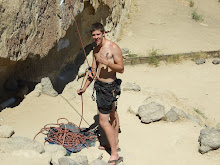Here's Michael's latest post, which he entitles "ouch." This email arrived this afternoon.
-----------
39.43 n 139.27 w
We have made our turn to the coast, but we are getting a strong side swell, rolling us badly, so we are trying some course adjustments to easy up the swell affect.
We made 150 miles yesterday, our most in a long time, we have been going from 6 -7 knts all day and night.
We have 801 miles to go. If we keep this up for 2 days, we will really get closer fast, then we are supposed to have 2 days NO winds. But we have lots of fuel left, so we will motor to the coastal winds.
WE have a problem. Last night we noticed that the gooseneck of the boom is cracked 1/2 way through on the starbd side, so i made clamps and was able to pull it back together, and it has held through the night.
but we are using 2 reefs and keeping slow, about 6+ kts to ease the pressure.
So we need some extraa prayer for mechanical mercies.
If it fails completely, i have ways of rigging the main loose footed, so we will still get home, but just slower, unless we get very stormy conditions and then we drop the main and only use the storm sail.
So, we will be ok.
thank you for your prayers
michael s/v goodnews
-----------
In case anyone is not familiar with sailing terms, the following might help. The "boom" is that huge horizontal bar that runs perpendicular to the mast and along the bottom of the big sail or mainsail. It's called a "boom" because when you tack or jibe it swings around and can cause lots of damage if it smacks your head. The "gooseneck" is a heavy duty ring that clamps the front of the boom onto the mast. It is subject to lots and lots of tension. "Starboard" is the right side and "port" is the left side. When Michael says he is using "2 reefs" it means the mainsail is not completely unfurled; he is only using part of the mainsail. That reduces the amount of wind that hits the mainsail and slows the boat down. It also reduces pressure on the gooseneck. The bottom of the mainsail is called the "foot" of the sail, so to speak of "rigging the main loose footed" means that the bottom of the mainsail, which is normally linked to the boom, is no longer linked to the boom but rather is held in place with one or more lines. A "storm sail" is small sail made of heavy gauge cloth.

No comments:
Post a Comment